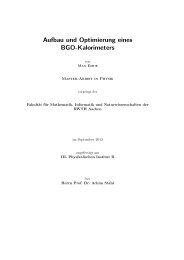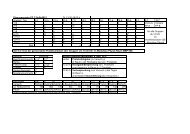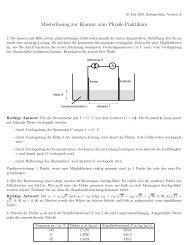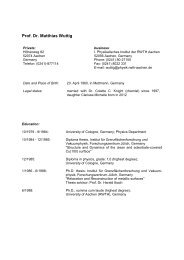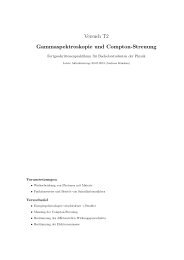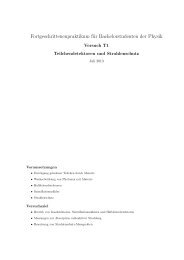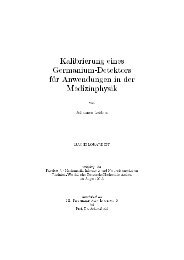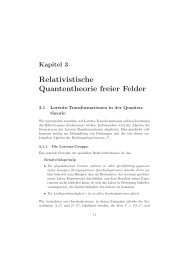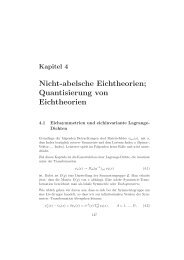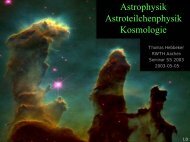Workshop book - Physikzentrum der RWTH Aachen - RWTH Aachen ...
Workshop book - Physikzentrum der RWTH Aachen - RWTH Aachen ...
Workshop book - Physikzentrum der RWTH Aachen - RWTH Aachen ...
Create successful ePaper yourself
Turn your PDF publications into a flip-book with our unique Google optimized e-Paper software.
Posters Monday February 4<br />
Poster 17:<br />
Rashba spin-orbit interaction in a quantum wire superlattice<br />
Sigurdur I. Erlingsson<br />
We study the effects of a longitudinal periodic potential on a parabolic<br />
quantum wire, and long quantum point contacts, defined in a two-dimensional<br />
electron gas with Rashba spin-orbit interaction. For an infinite wire<br />
superlattice we find that the energy gaps are shifted away from the usual<br />
Bragg planes due to the Rashba spin-orbit interaction. We have also calculated<br />
the charge conductance through a periodic potential of a finite length<br />
via the nonequilibrium Green’s function method combined with the Landauer<br />
formalism. We find dips in the conductance that correspond well to<br />
the energy gaps of the infinite wire superlattice. From the infinite wire energy<br />
dispersion, we <strong>der</strong>ive an equation relating the location of the conductance<br />
dips as a function of the Fermi energy to the Rashba spin-orbit coupling<br />
strength. We propose that the strength of the Rashba spin-orbit interaction<br />
can be extracted via a charge conductance measurement.<br />
Poster 18:<br />
Electronic states in a cylindrical nanowire in magnetic and electric fields<br />
Andrei Manolescu<br />
Single particle states of electrons situated on a closed cylindrical surface of<br />
radius 30-100 nm are calculated. The length of the cylin<strong>der</strong> may be either<br />
infinite or finite. In the presence of a magnetic field uniform in space, but perpendicular<br />
to the longitudinal axis of the cylin<strong>der</strong>, the orbital effects depend<br />
on the radial component of the magnetic field. For a sufficiently strong field,<br />
when the magnetic length becomes comparable to the radius of the cylin<strong>der</strong>,<br />
the orbital motion corresponds to closed cyclotron orbits in the regions with<br />
strong radial field, but to open quasi one-dimensional snaking orbits in the<br />
regions where the radial field vanishes and changes sign. The energy of the<br />
cyclotron states increases with the magnetic field relatively to the energy of<br />
the snaking states such that at high magnetic fields the electrons concentrate<br />
around the snaking orbits. The spin of the electron is included via Zeeman<br />
and Rashba spin-orbit effects. A uniform electric field perpendicular to the<br />
cylin<strong>der</strong> is also consi<strong>der</strong>ed, as being produced by a metallic electrode placed<br />
near the cylin<strong>der</strong>. In this case the spin-orbit coupling becomes anisotropic.<br />
Attempts to include Coulomb effects in the Hartree-Fock approximation are<br />
discussed.<br />
69





